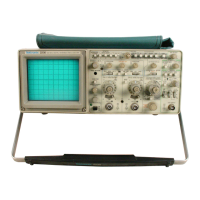Options and
Accessories-2230
Operators
Commands
ALL
FLOw
<[ON]
or
OFF>
ALL
REMote
<[ON]
or
OFF>
ALL
STOP
<1
or
2>
ALL
STAtus?
7-46
Table 7-33
RS-232-C Specific Commands
Description
Enables
(ON)
or disables
(OFF)
DC1
/DC3 flow control. FLOW
ON
is
the default
and
power-on state. Binary data transfers cannot
be
made with
FLOW
ON.
A
FLOw? query returns the present state,
ON
or
OFF.
With FLOW
ON,
the
<control-S>,
<control-0>,
and
<control-•> are
recognized during data transfers. Their functions
are
as
follows:
< control-S >
<control-0>
<control-•>
Temporarily suspend output of characters.
Resume character output that
has
been
temporarily suspended.
Abort the command or query execution; erase both
input
and
output buffers; reset the message
processor.
Enables
(ON)
or disables
(OFF)
setting of remote-controllable oscilloscope
states.
An
execution error service request is sent if a control command
is
sent
with
REM
OFF.
REM?
returns the present state,
ON
or
OFF.
Sets the number of stop bits used
in
transferring character codes. The usual
selection
is
1 though some printers require two stop bits at certain baud rate
settings. STOP
is
set to 1 at power on.
When
connecting to a printer or plotter,
select a baud rate that uses only one stop bit.
STOP? returns the present setting, 1 or
2.
Returns the current status of the instrument. If
no
service requests
are
pending,
the status byte returned indicates
No
Status to Report. If ROS
is
off,
an
EVEnt?
query must
be
used to find out if
an
event occurred
and,
if
so,
which
one.
The
EVEnt? query produces more useful information about
an
event than the service
request status byte.
--

